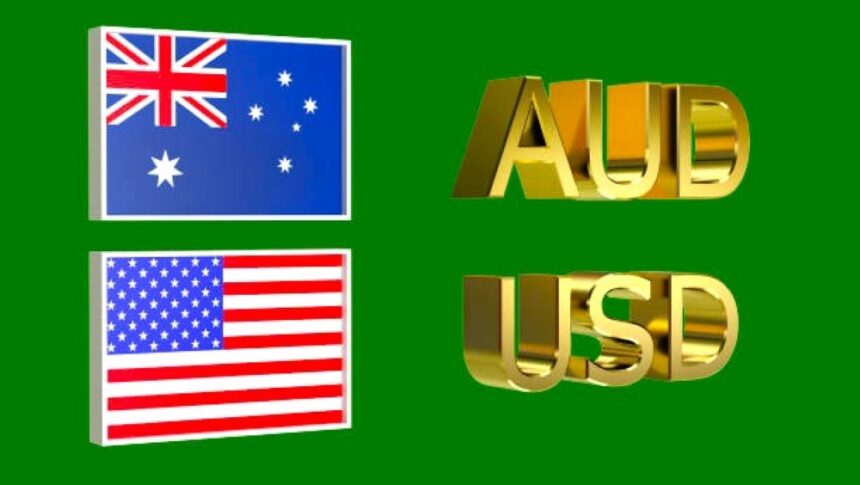The Australian Dollar (AUD) sustained its upward trajectory against the US Dollar (USD) on Monday, bolstered by a hotter-than-expected domestic inflation gauge and supportive trade developments. The AUDUSD pair remained buoyant for the second straight session, shrugging off broader market volatility driven by disappointing US Nonfarm Payrolls (NFP) data and fresh trade policy shifts from the United States.
Disclaimer: This blog is for informational purposes only and does not constitute financial advice. Always conduct your own research and consult a professional advisor before making investment decisions.
[sc_fs_multi_faq headline-0=”h2″ question-0=”Why did the Australian Dollar rise today?” answer-0=”The AUD rose due to stronger-than-expected inflation data from the TD-MI gauge, Australia’s exemption from new US tariffs, and a weaker US jobs report that fueled expectations of Fed rate cuts.” image-0=”” headline-1=”h2″ question-1=”What is the TD-MI Inflation Gauge?” answer-1=”The TD-MI Inflation Gauge is a monthly measure of inflation trends in Australia, produced by TD Securities and the Melbourne Institute. It is used as a leading indicator of consumer price movements.” image-1=”” headline-2=”h2″ question-2=”Is the RBA expected to raise interest rates soon?” answer-2=”While the RBA has been cautious, the latest inflation data may force a reassessment. If inflation continues to rise, the RBA could consider tightening monetary policy in the near term. ” image-2=”” count=”3″ html=”true” css_class=””]
Inflation Surprise Lifts RBA Policy Uncertainty
The July TD Securities–Melbourne Institute (TD-MI) Inflation Gauge showed a sharp 0.9% month-over-month jump, marking the highest rise since December 2023. This comes after a relatively subdued 0.1% increase in June and pushes the annual inflation gauge to a steady 2.4%.
The pronounced monthly spike reinforces lingering price pressures across Australia’s consumer economy, which could further complicate the Reserve Bank of Australia’s (RBA) path forward. While the RBA has maintained a relatively neutral tone in recent meetings, this fresh inflation data may trigger hawkish repricing as it suggests rising input costs and renewed pressure on consumer prices.
Investors now speculate whether the RBA could pivot from its data-dependent wait-and-see stance and adopt a more proactive posture in light of sticky inflation dynamics. Though headline inflation has cooled in annual terms, resurging monthly figures could delay any potential easing, especially amid global uncertainties.
Trade Relief: Australia Escapes US Tariff Hikes
In a notable geopolitical development, Australia was excluded from the latest round of tariff hikes announced by US President Donald Trump, offering crucial support to the Aussie Dollar. While the US levied tariffs ranging from 10% to 41% on dozens of nations including Canada, India, and Taiwan Australia retained preferential access under a zero-tariff status.
According to Australia’s Trade Minister Don Farrell, no country enjoys lower reciprocal tariffs than Australia, an assertion backed by White House assurances. This bolsters Australia’s export competitiveness, particularly in key sectors such as agriculture, resources, and manufacturing.
The exemption provides Australian exporters an opportunity to increase market share in the US, especially as global trade realignments unfold. It also removes a significant downside risk to the AUD, which had previously come under pressure from tariff-related uncertainty.
US Jobs Miss Deepens Fed Rate Cut Expectations
The US labor market added just 73,000 jobs in July, significantly below consensus expectations of 110,000. Compounding concerns, the June figure was revised sharply lower to 14,000 from an initially reported 147,000. Meanwhile, the Unemployment Rate ticked up to 4.2%, in line with forecasts but still reflective of a cooling labor market.
The tepid job creation has prompted markets to price in two interest rate cuts from the Federal Reserve by year-end. Fed Funds Futures now reflect an increased probability of a cut as early as September, with the second expected by December.
Despite the dovish repricing, the US Dollar Index (DXY) rebounded mildly to 98.70 in early Monday trade, recovering from Friday’s sharp pullback. Investors remain cautious ahead of more clarity from the Fed, particularly regarding the inflationary impact of Trump’s new tariff actions.
Fed Maintains Rates, Powell Cautious on Policy Path
At its July meeting, the Federal Reserve left interest rates unchanged in the 4.25%-4.50% range, as widely anticipated. Fed Chair Jerome Powell struck a cautious tone in his post-meeting remarks, noting that the central bank has “made no decisions” about a policy change in September and that more time is needed to assess the impact of tariffs on inflation and consumer spending.
Powell’s emphasis on economic uncertainty and crosswinds, especially from international trade dynamics, suggests a more data-contingent approach in the months ahead. Markets interpreted his comments as a signal that the Fed remains open to easing if macroeconomic conditions deteriorate further a factor capping USD gains and supporting high-beta currencies like the Australian Dollar.
Global Trade Tensions Still Simmer Despite Some Progress
While Australia gained a reprieve from tariffs, broader trade tensions remain front and center:
The US and China failed to reach an agreement on extending the 90-day tariff pause during talks in Stockholm, Sweden. The pause expires on August 12, leaving markets on edge.
Existing US tariffs on Chinese goods have been reduced from 145% to 30%, while China’s retaliatory tariffs were cut from 125% to 10%, offering temporary relief but still leaving the door open for renewed escalation.
Meanwhile, Trump announced a new trade pact with South Korea, imposing a 15% US tariff on Korean imports alongside a $350 billion South Korean investment commitment.
Separately, the US and European Union finalized a trade agreement that applies 15% tariffs to most European goods, taking effect from August 1.
These developments reflect an increasingly fragmented global trade environment, with uncertainty over future tariff decisions continuing to influence risk appetite and currency flows.
China’s PMI Miss and Fiscal Response
From Asia, China’s Caixin Manufacturing PMI fell to 49.5 in July, dipping below the neutral 50 level and missing expectations of 50.3. This contractionary reading reflects sluggish external demand and weakening domestic momentum, intensifying the pressure on Beijing to stimulate growth.
In response, China’s Finance Minister Lan Fo’an emphasized a more proactive fiscal policy stance aimed at supporting domestic consumption and stabilizing the broader economy. This could potentially benefit Australian exports, particularly commodities, if stimulus measures translate into increased infrastructure or industrial demand.
Australian PPI Slows But Remains Elevated
On the price front, Australia’s Producer Price Index (PPI) rose 0.7% QoQ in Q2, slightly below expectations of 0.9%. On a yearly basis, PPI climbed 3.4%, easing from the previous 3.7%. The slower producer-side inflation reading contrasts with the surge in consumer-side inflation captured by the TD-MI gauge, presenting a mixed picture for the RBA.
While the producer cost pipeline appears to be moderating, persistent consumer inflation raises questions about demand-pull versus cost-push dynamics, and whether pricing pressures may become entrenched without further monetary intervention
Market Outlook: Can the Australian Dollar Sustain Momentum?
The near-term outlook for the AUDUSD pair remains cautiously constructive, though contingent on several moving pieces:
A potential RBA hawkish shift: If upcoming data reaffirms price pressures, the RBA may be forced to revisit its neutral stance, which could further bolster the Australian Dollar.
Fed rate cut expectations: Weaker US data and rising trade uncertainty increase the probability of Fed easing, which typically weighs on the USD and benefits risk currencies.
China stimulus impact: Any material fiscal push from Beijing could support Australian export volumes, given the two countries’ deep trade ties.
On the downside, risks include further deterioration in global growth conditions, especially if the US-China tariff ceasefire breaks down after August 12. A negative surprise from Chinese economic data or disappointing Australian employment figures could also drag the Aussie lower.
Conclusion: Aussie Dollar Finds Ground Amid Policy Crosswinds
The Australian Dollar has emerged resilient amid a complex mix of local inflation surprises, global tariff shifts, and shifting central bank expectations. With Australia sidestepping US trade penalties and domestic inflation showing signs of heating up, the AUD stands well-positioned — for now — in the G10 currency space.
However, the next leg of AUDUSD movement will likely hinge on whether the RBA pivots hawkishly, the Fed signals imminent easing, and global trade policy developments stabilize or escalate. In this fluid macro environment, traders will remain glued to both central bank commentary and geopolitical trade headlines for direction.









